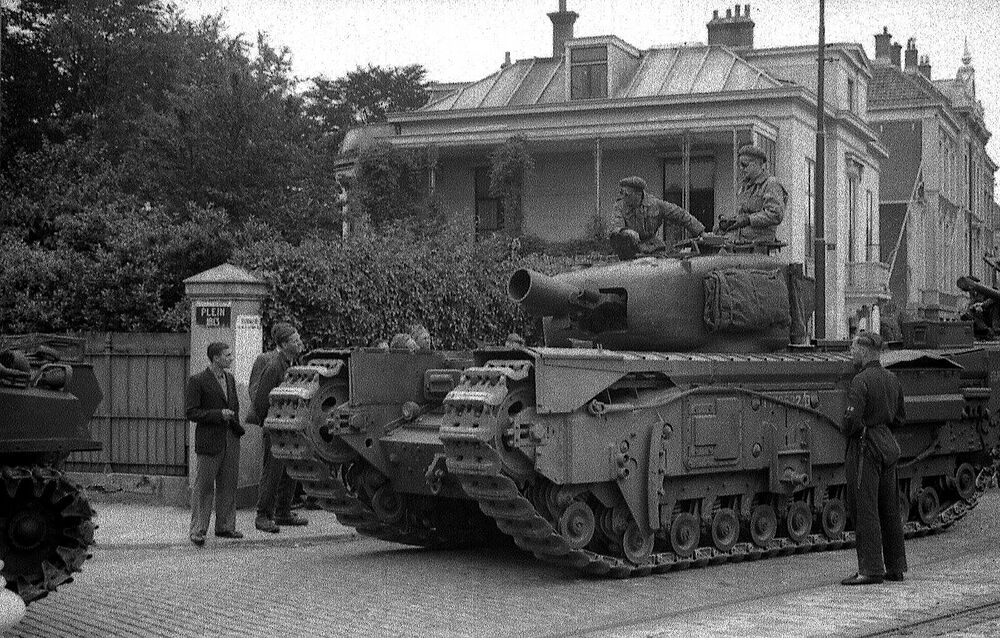- Yes
- No
Churchill Mk. III/IV AVRE
Design and development of the Churchill AVRE began in October of 1942 after the realisation that a heavy duty demolition vehicle was needed following the disastrous Dieppe Raid. The Royal Engineers needed a vehicle capable of destroying heavy duty obstacles and bunkers. Seeing as the traditional howitzers and heavy artillery guns were not viable to be fit into the turret of the Churchill, it was decided that drastic measures must be taken. The interior was mostly stripped, in order to make way for the massive demolition charges and other engineering implements.

Instead of a traditional howitzer or mortar, it was decided to use the Petard 29mm Spigot Mortar. Essentially a super-sized PIAT launcher. The charge itself, the No. 1 Demolition Bomb, consists of a socket which fits over the spigot part of the mortar itself. At the base, as seen in the photograph above are the stabilising fins of the charge. Beyond this, is the explosive charge itself. With a 40lb explosive warhead, it was expected to clear bunkers and other battlefield obstacles with ease.

The No. 1 Demolition Bomb is loaded similarly to a break-action shotgun. First the turret must rotate forward, with the mortar above the assistant drivers hatch. With the tube of the launcher folding up, allowing the assistant driver to move open his hatch and load the launcher. This is obviously a dangerous task for the man loading it, since he must expose his arms to the outside world whilst operating.

close up of the Petard 29mm Spigot Mortar and No. 1 Demolition Bomb on a Churchill Mk. III AVRE.

Churchill Mk. IV AVRE with its hatches open and carrying fascines for trench crossing. You can see the Petard mortar in the loading position.
After a relatively short development time of 4 months, the first Churchill AVRE’s began production in January of 1943. According to the National Archives at Kew, a letter from the War Office to the Ministry of Supply, dated 10 November 1943, 475 Churchill tanks had been converted into AVRE’s. So in the span of 11 months, almost 500 Mk. III and IV tanks had been converted.
The first combat use of the Churchill AVRE was on D-Day. Where they were used to clear the enemy beach fortifications. AVRE’s would continue to be used throughout the war, and as the months of fighting would progress, new doctrine was introduced to increase the effectiveness of the machine. Eventually being used in conjunction with the Churchill Crocodile flame tank, the Croc would torch the fortifications, and if the fortifications still stood, the AVRE would lob its 40lb warhead to finish it off.

Churchill Mk. III AVRE leading a Sherman Firefly through the dense Bocage of Normandy.
During the push through Normandy, the AVRE would have its only recorded tank kill on D plus 11. 17 June 1944, near Tilly-sur-Seulles. During the fierce fighting in and around Tilly, an AVRE, while supporting infantry was spraying a hedgerow with machine gunfire; however, the crew was startled when instead of seeing infantry, a Panther rolled out from behind the hedgerow. The commander quickly ordered the turret around to face the big cat. At a range of no more than 50 yards, the gunner pulled the trigger, sending the 40lb explosive flying at the Panther. The huge bomb detonated against a telegraph line a mere 3 feet from the Panther. When the dust settled, the Panther was still. Presumably the crew had been killed from the over pressure.

Specifications:
Crew: 6
Armament: 1x Petard 29mm Spigot Mortar, 2x 7.92mm BESA machine guns.
Powerplant: 1 Bedford Twin-Six petroleum engine, producing 350 horse power.
Weight: 38 Tons
Performance: 15mph on road
Dimensions: length 25’ 2”; Width 10’ 8”; Height 9’ 2”.
The Churchill AVRE would be a very unique addition to the game, being a difficult to master heavy tank or TD, likely playing similarly to the German Sturmtiger. 40lbs of HE is nothing to scoff at!


Sources:
Nash, Mark. “Churchill A.V.R.E.” Tank Encyclopedia, 16 May 2023, Churchill A.V.R.E. - Tank Encyclopedia.
Bishop, Chris. The Encyclopedia of Weapons of World War II. United States, MetroBooks, 2002.
Futter, Geoffrey W… The Funnies: The 79th Armoured Division and Its Specialised Equipment. United Kingdom, Model and Allied Publications Limited, 1974.

